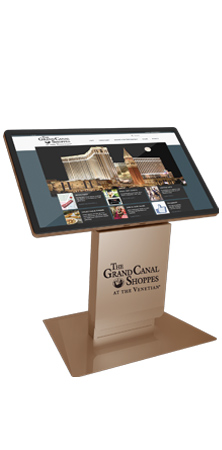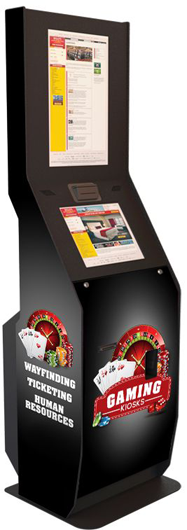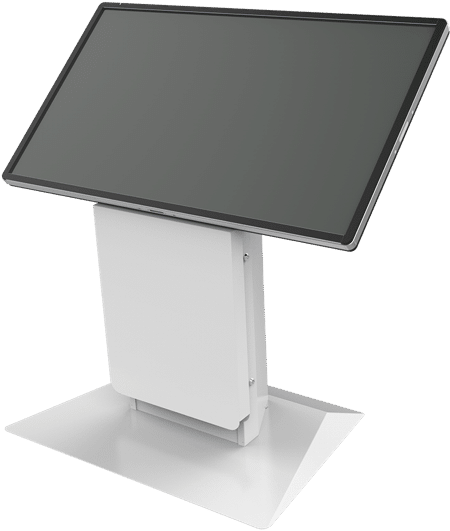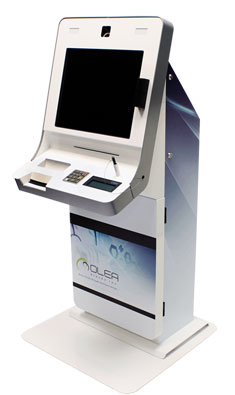
Interactive kiosks are everywhere! Nearly every day in the news there is a new story of kiosks being deployed in a wide variety of applications intended to create greater efficiency in a variety of industries, including retail, food service, casino gaming, government agencies, school campuses, and more.
With so many success stories, many businesses see digital kiosks as a “magic bullet” that is going to increase revenue while cutting costs. While this is often the case, it is still important to look at a kiosk deployment as a strategic project that involves planning, execution, and follow-up to ensure that the kiosks are maximizing their potential and generating the most revenue in the most efficient deployment.
Location and Convenience Are Key!
Frank Olea, owner of Olea Kiosks, often compares interactive kiosk deployment to selecting a real estate location for a commercial business. Location and convenience are critical to a successful kiosk project, and as Olea says, kiosks are like retail stores, and “just because it exists, doesn’t mean people will go there.” The primary purpose of self-service kiosks is convenience, but if the kiosk isn’t placed in a convenient location, the kiosk inherently is no longer convenient.
As Olea says, “people naturally choose the path of least resistance,” so when confronted with any difficulty, such as an inconvenient location, customers will choose an easier option. For example if your favorite restaurant with self-service has a shortage of parking spaces and requires 20 minutes to look for parking, you are probably going to leave and find a more convenient option, no matter how much you may love the food. After a few instances of parking lot frustration, you probably will stop even considering that restaurant as an option.
The same can be true of kiosks. If a kiosk is placed in an out-of-the-way location or consistently has long lines, then consumers will naturally look for a more convenient option.
5 Tips for Success
The following are a few tips that will help ensure your kiosk deployment is able to help you to achieve your goals:
1. Clearly Define the Kiosk’s Business Objectives and the Potential Audience
Interactive kiosks have become such dynamic machines that they are able to handle nearly infinite numbers of business functions. It is important when planning a kiosk project that you clearly define the business objective for the kiosk as well as define the demographics of the group that will be using the kiosk.
The kiosk’s objectives and the potential audience can influence the design of the physical unit, the selection of optional components, and the design of the user interface. For example, with a healthcare kiosk, it is often important to provide an ADA compliant solution, which means that all components on the kiosk need to be accessible to all users, and the user interface must provide a solution for impaired users. Similarly, while a standard wayfinding kiosk can be a straightforward solution, there are many options that can be considered, such as the addition of banner ads to the user interface, which can make the kiosk project more successful.
Additionally, consider the volume of traffic and portability of the kiosk. While some kiosks are built to be completely portable with extremely modular lightweight components, such as Olea’s TapSnap portable photo booth, other kiosk projects have to deal with the rigors of a high volume of users every day, such as Olea’s ADOT vehicle registration renewal kiosks. Understanding the potential volume of users will ensure that your kiosk will be able to provide an effective long-term business solution.
An experienced kiosk builder, such as Olea, will work closely with its customers to identify who will be using a kiosk, how it will be used, and the likely number of users, and then develop a comprehensive design specification that directly caters to these factors. The more clearly you are able to define your objectives, the more likely the kiosk will be able to satisfy your goals.
2. Promote Your Kiosks!
Studies have shown that 85% of adults use kiosks for self-service transactions, so there is a tremendous interest in and demand for new kiosk deployments. As such, be sure to promote your new kiosk deployment with visible signage on and around your kiosks to ensure that it captures the attention of potential new users that are passing by.
Consumers have quickly become so accustomed to using self-service interactive kiosks that they not only prefer these self-service options, but they have now come to expect it! Make sure that you are supporting your kiosk deployment with enough promotion so that new users know it’s there. Also bill payment kiosks have become very popular with our customers.
3. Use Human “Stewards”
As mentioned above, there is a huge demand for self-service solutions, such as interactive kiosks, but sometimes humans can be resistant to change. Once we get comfortable using a particular product or service in a way that suits us, we may be reluctant to try something new or different.
When customers encounter a new kiosk, there may be some trepidation to try this new system, but this situation can be overcome by training customer service staff to closely monitor users of the kiosks and function as “stewards” for those users that encounter any difficulties. With human staff able to offer immediate guidance on the kiosk’s functionality, consumers will more quickly adapt to the new self-sufficient system and are more likely to become dedicated kiosk users.
Typically, once a customer gains confidence in a self-service solution, they are likely to prefer that self-service option for every transaction, which can increase customer satisfaction and provide greater overall efficiency. By using human “stewards” to guide the user through any difficulties, there is a greater likelihood that customers become dedicated long-term kiosk users.
4. Strategic Kiosk Placement
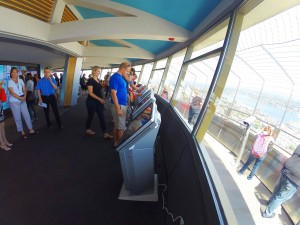
When initiating a new kiosk deployment, it is important to gather as much data as possible on current users of your services and to develop projections of estimated potential users of the new kiosk systems. In addition, it is often useful to create a schematic of your floor plan so that your kiosk manufacturer can work with you to determine the best solution for your needs.
For example, if you are deploying a wayfinding solution, you want to make sure that the kiosk is positioned in the highest traffic areas, but deployed in a location that will be unobtrusive to the flow of traffic. Similarly, for retail kiosks that provide SKU lookup functionality, product shopping capabilities, and a self-checkout system, it is typically most beneficial to deploy the kiosk near existing POS machines so that customers transition from human POS systems to the new self-service kiosk options.
5. Analyze Data and “Split-Test”
After a new kiosk project is launched, the project typically is not finished. Once the kiosks go live, it is important to begin the data tracking and analysis phase. Kiosk software can be configured with advanced tracking software that can provide detailed information on a variety of usage statistics including total users, average session duration, transactions started/finished (for retail kiosks), and user goals accomplished (i.e. new accounts created, loyalty cards issued, wayfinding map requests, etc.).
From this data, a business can often further optimize its kiosk deployment. For example, by using the old advertising technique of “split-testing,” a retail business can test multiple up-sell and cross-sell options to determine which is the most successful and drives the greatest ROI.
Similarly, it can sometimes be beneficial to “split-test” the physical location of kiosks in a store or facility. For example, in a retail setting, it may be beneficial to split test the placement of a kiosk near the entrance, near a POS system, and near the busiest thoroughfares to see not only the volume of users in each location, but also how the kiosks are being used – e.g. wayfinding, product lookup, UPC scanning, etc.
By closely monitoring the performance of a kiosk through the data provided through the kiosk analytic systems, the kiosk deployment can be tweaked and fine-tuned to ensure it is generating the best ROI for your business.
Award-Winning Interactive Kiosk Manufacturer
Olea Kiosks has been building award-winning interactive kiosks for over 40 years. We work closely with our customers in all phases of a kiosk project, including planning, manufacturing, deployment, and post-deployment follow-up to ensure that our kiosks generate the greatest ROI to our customers. Contact Olea today to find out how our interactive kiosk solutions can benefit your business.
